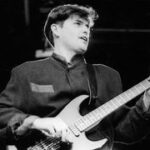Green Day’s “Boulevard Of Broken Dreams” resonates with so many for its melancholic yet powerful sound. As a staple for guitar players, learning this iconic song is a must. This lesson breaks down every guitar part in “Boulevard Of Broken Dreams,” providing you with the knowledge to play it just like Green Day. Whether you’re strumming the acoustic chords or diving into the electric guitar solo, we’ve got you covered.
Tuning and Capo: Setting Up Your Guitar
To accurately play “Boulevard Of Broken Dreams”, you’ll need to tune your guitar to standard tuning (E A D G B E). Green Day actually uses two guitar parts in the studio and live performances. The acoustic guitar is played with a capo on the 1st fret. This allows for open position chords that create the song’s signature strumming sound. The electric guitar part, however, is played in standard tuning without a capo. We’ll explore both approaches so you can choose what suits you best or even play along with both parts!
Acoustic Guitar Chords: The Heart of the Song
The acoustic guitar part forms the rhythmic and harmonic foundation of “Boulevard Of Broken Dreams.” Using a capo on the first fret allows you to play familiar open chords, making the song accessible for many guitarists. While it sounds best with a capo, we’ll also show you how to play the chords without one, giving you flexibility. The strumming patterns are relatively straightforward, focusing on downstrokes and a steady rhythm that drives the emotional feel of the verse and intro.
Electric Guitar Melodies in the Verse
While the acoustic guitar provides the chords, an electric guitar adds subtle yet crucial melodic lines during the verses. These melodies aren’t overly complex but add texture and interest to the song. We’ll break down these single-note lines, showing you where they fit in the song and how to play them cleanly. These electric guitar fills are essential for capturing the full arrangement of “Boulevard Of Broken Dreams.”
Chorus Power Chords: Unleashing the Distortion
When the chorus hits, Billie Joe Armstrong switches to a distorted electric guitar and delivers a powerful power chord progression. This is where the energy of the song elevates. The power chords are fundamental guitar shapes, making the chorus impactful yet easy to grasp. We’ll detail the exact power chord progression and strumming rhythm used in the chorus, ensuring you can nail this anthemic part of the song.
Guitar Solo: Octave Licks
The guitar solo in “Boulevard Of Broken Dreams” is memorable for its use of octaves. Playing octaves involves playing the root note and a note an octave higher simultaneously, creating a thicker, punchier sound. This solo isn’t about shredding speed but about melodic phrasing and controlled bends within the octave shapes. We will guide you through this solo note-for-note, focusing on the octave technique and bending accuracy to replicate the solo authentically.
The Eerie Outro: Vibrato and Sustained Octaves
The ending of “Boulevard Of Broken Dreams” is a masterclass in creating atmosphere. It features two distinct electric guitar parts that intertwine. The main part is a single-note riff played with heavy vibrato. Vibrato is a technique of slightly varying the pitch of a note, creating a wavering, expressive sound. Complementing this riff is a second guitar part holding a sustained octave, which adds a haunting, eerie quality to the outro. This combination is a signature Green Day sound and a fantastic way to conclude the song.
“Boulevard Of Broken Dreams” is a rewarding song to learn for any guitarist. By understanding these different guitar parts and techniques, you’ll be able to play this Green Day classic in its entirety. Practice each section slowly at first, gradually increasing speed as you become more comfortable. Have fun exploring the acoustic strumming, electric melodies, power chords, octave solo, and the atmospheric outro of this iconic song!


